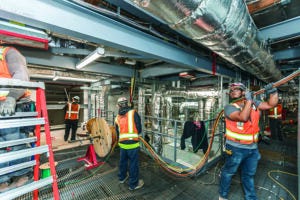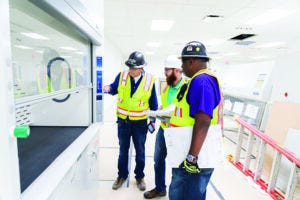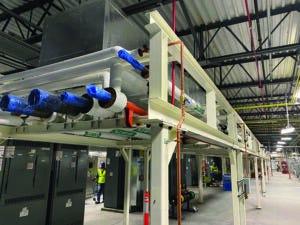- Sponsored Content
Lean Project Delivery Goes Mainstream, but Can It Stay?Lean Project Delivery Goes Mainstream, but Can It Stay?

Driven by the urgency of the COVID-19 pandemic, the US government’s Operation Warp Speed (OWS) initiative gave biomanufacturing-facility design and construction teams an opportunity to unleash their creativity and put forth innovative solutions. Although the exigency for SARS-CoV-2 vaccines has declined, the life-science industry’s lightning-fast pandemic response has left a lasting impression among many companies. For instance, today’s biomanufacturers might wonder why facility construction should take four or five years when the industry has shown that it can be done in 18 months with the right tools and strategies. The pandemic took integrated project-delivery methods mainstream. It also enabled lean business principles and modularization to gain in popularity. But questions remain about how quickly the biomanufacturing industry will adopt such approaches moving forward.
Addressing Business Challenges
Lean project delivery is a business philosophy that can alleviate constraints facing today’s facility design and construction industry (1). Grounded in the goal of continuous improvement, a lean delivery process focuses on delivering value to customers (facility sponsors) with the least waste possible. The lean approach removes silos to optimize entire projects rather than just their parts. Organizations, project teams, and individuals all can benefit from the agility, resilience, and reliability of results generated by a lean culture.
Lean design and construction principles differ from traditional strategies in several ways. Past projects almost always involved “stage-gating.” First, a design team would conduct a feasibility study, followed by a pause in activity. Next up was concept design, followed by another pause — and so on until project completion. Because of that linear approach, most facility projects were spread over several years. The industry’s pandemic response challenged the value of linear design processes by highlighting the merits of overlapping timelines for design and construction.
A primary way that lean principles speed up design and construction is by bringing better partnerships to the industry (1). Rather than having designers, engineers, builders, and project sponsors working apart in silos, the lean philosophy encourages coming together — early and often — to create a high-quality product. It’s about making decisions together in real time rather than passing finished work back and forth, undoing and redoing it along the way. Note that a lean approach does not necessarily reduce the number of team members; the strategy is not about eliminating resources, but rather using them more efficiently through collaborative workflows among all project stakeholders.
 Shifting the Industry Mindset
Shifting the Industry Mindset
Although many biomanufacturing companies want to leverage the benefits of a nimble approach to design and construction, the overall industry might take a while to adopt a lean mindset. Despite the desire for speed, traditional requests for proposals (RFPs) remain the norm. And when it comes time to apply some of the cutting-edge aspects of a lean approach, such as sharing both risks and rewards or bringing in trade partners early, project sponsors often push back. “But this is the way we’ve always done it!” continues to ring out during boardroom meetings.
With pandemic subsidies ending and a noticeable downturn across financial markets, many biopharmaceutical companies are dealing with rising costs, delaying capital expenditure, and returning to “business as usual” (2). In a time of economic uncertainty, many executives hesitate to embrace innovative project-delivery methods.
At the same time, rapid changes in science, technology, and marketplace demand are preventing some fledgling life-science companies from fully fleshing out their business cases before engaging design and construction partners. Therefore, biotechnology start-ups often hedge their bets on what seems to be the most likely industry situation in five or 10 years. That might seem to be a problem, but it is a significant opportunity to leverage the benefits of lean construction and modularization.
 The State of Modularization
The State of Modularization
Modular facility design divides a system into smaller parts, which can be created, modified, or replaced independently. They even can be swapped out with other modules as needs change. Modularization gives project teams opportunities to learn, adapt, iterate, and scale rapidly. All those features can translate into big wins for life-science companies, delivering value long after design and construction have ended.
Modular facility design has yet to hit its tipping point within life sciences. Although a handful of biotechnology companies have become early adopters, those organizations have tended to favor bespoke designs. To reduce costs, companies often try to shave off space in a new facility and squish in as much equipment as possible. But that approach complicates design and construction. It also sometimes leads to bloated buildings with “just-in-case” contingencies. Such measures can be outdated by the time that they are used, resulting in long-term waste and inefficiency for manufacturing systems as well as wasted design and construction effort for redesign.
The biomanufacturing industry still exhibits somewhat of an all-or-nothing mentality about modularization. But the issue does not need to be so polarizing. A modular approach enables but does not force an entire spectrum of options. For example, instead of constructing an entirely modular facility, teams can build major (or minor) sections of a plant off site through remote-assembly operations. Those sections could include portions of single- or even multitrade systems, from simple wall and ceiling panel systems to utility racks, equipment skids, and all the way up to the largest transportable facility units and components.
 Benefits from Modularization
Benefits from Modularization
The biopharmaceutical industry is uniquely positioned to benefit from modularization within facility design and construction. For example, modular approaches support process intensification. The future of the life-science industry is intensification, from improving chemical synthesis to making biomanufacturing processes more sustainable and reducing facility footprints. Increasing adoption of process intensification ultimately will result in smaller, more efficient facilities in which modularization will be more valuable than ever. As processes improve, biomanufacturers will find much value in having the flexibility to retrofit existing spaces rather than needing to build new ones. Interested companies would do well to modularize their processes before doing so with entire facilities.
Modularization can streamline decision-making. Because modular components can be produced easily and quickly in the controlled and repeatable conditions of a factory, project teams for biomanufacturing-facility builds often can defer certain technical decisions until later in a project life cycle. That capability gives teams more time to clarify business and process drivers and details, integrate lessons learned, and optimize delivery approaches. Put simply, modularization within design and construction has a compounding effect that allows progressively more time for iterative decision-making throughout a facility’s life cycle.
Modular approaches to design and construction also support scalability. Companies that choose to leverage agile and adaptable components (e.g., workcells, standardized floor and wall panels, and speculative space for cleanrooms) are well positioned to accommodate changing workforces, fluctuating supply chains, and digitalization efforts. Such companies also can scale up their facilities rapidly as their business cases demand it — with little risk to ongoing operations. For example, in CRB’s 2022 Horizons: Life Sciences report, 63% of survey respondents identified their companies’ use of preconstructed speculation space to pursue expansion of laboratories and/or current good manufacturing practice (CGMP) sites (3).
Modularization enables biomanufacturers to standardize operating procedures. In the 2022 Horizons report, 53% of almost 500 respondents with multisite operations reported some difficulties with adhering to procedures across their CGMP sites (3). Modular systems and components enable biomanufacturers to standardize operations and procedures within their networks. In turn, companies can develop streamlined training approaches for repeatable and predictable scenarios rather than creating one-off guidelines.
On a related theme, modularization within life-science facilities could help to address labor shortages for both construction and operation. Facility modularization enables more building work to be performed off site, thereby reducing risks associated with dwindling pools of trade labor. And with repeatable, standardized onsite processes, operators can be onboarded easily and even relocated to other facilities if needed. There are potential cost savings, too. Simplified processes take pressure off of companies to build only in expensive areas typically associated with skilled-labor availability.
Repeatable modular designs reinforce facility-expansion efforts. Most Horizon survey respondents reported that their companies planned to expand operations in the next five years, with some organizations intending to establish sites in other countries (3, 4). To optimize capital and operational expenditure during such expansion efforts, companies must standardize operations across sites, expedite regulatory approvals, and remain agile to accommodate demand for new drug modalities and manufacturing technologies. Designing facilities with standardization and repetition in mind not only reduces long-term design and engineering costs, but it also reduces overall project risk. Sponsors can certify each module within a global biomanufacturing network to satisfy the highest and most universally accepted standards, modifying for local conditions only as needed. Modularization also allows companies to build facilities with nearly identical components, facilitating operator cross-training.
 Thinking Long Term
Thinking Long Term
As life-science companies continue to diversify their product pipelines, they will benefit from shifting away from bespoke facility designs and instead leveraging repeatable, flexible ones. Currently, design and construction decisions often focus on lowering upfront capital costs rather than managing long-term operating expenses. But such approaches are hasty. Leveraging the benefits of modularization and flexible facilities requires consideration of the long term.
A stronger focus on future flexibility can be understood as low-cost insurance against shifting priorities and changing processes. Leveraging modularization ensures that a facility can be used optimally in the future without needing budget-busting retrofits. Modularization enables biomanufacturers to expand their facilities in controlled ways, which is especially important considering the recent market downturn. And with its focus on refinement rather than reworking, modularization is well suited to supporting facility retrofits as manufacturing needs change.
As we head into the future of the life-sciences industry, we need to discuss modularization on a project’s first day. Starting with the premise that a facility could be built completely off site opens up an entirely new set of possibilities. Of course, not every tool needs to be used on every project. But by promoting a mentality of modularization and bringing on trade partners early, biomanufacturers can help to ensure that facility construction flows naturally from designs that will address their short- and long-term needs. Such optimization immediately reduces rework, increases facility quality, and improves the safety of working conditions.
OWS set a new standard for the biomanufacturing and construction industries. We need to continue leveraging the trends that have emerged — including the push to adopt modularization and lean design and construction — to build facilities for life-saving products now and in the future.
References
1 McConaughy T. The Definitive Guide to Lean for Design and Construction Teams. CRB, 2023; https://www.crbgroup.com/insights/guide-to-lean-construction.
2 Masson G. After Pandemic Breather, Big Pharma Sees Drug Development Costs Rise and Returns Sink. Fierce Biotech 8 February 2023; https://www.fiercebiotech.com/biotech/it-cost-23b-develop-asset-2022-more-2021-while-return-dropped-deloitte.
3 Horizons: Life Sciences, 2022. CRB, 2022; https://go.crbgroup.com/2022-horizons-life-sciences-report.
4 Linton G. Expanding Global Operations with Standard Facility Design. CRB, 2023; https://www.crbgroup.com/insights/biotechnology/standard-facility-design.
Tammy McConaughy ([email protected]) is a fellow in lean project delivery at CRB and a certified instructor for the Lean Construction Institute. J.P. Bornholdt, PE, AIA, is a facility planning and integration specialist at CRB and a licensed architect and engineer.
You May Also Like





